#Willie Pickens
Photo

Willie Earle is shown in a police mug shot. Accused of robbing and killing a white taxi driver, he was lynched by a group of whites in 1947. On February 17, 1947, Willie Earle, a twenty-four year old African-American man, was being held in the Pickens County Jail in South Carolina, on charges of assaulting a white taxi cab driver. A mob of white men, mostly taxi cab drivers, seized Mr. Earle from the jail, took him to a deserted country road near Greenville, brutally beat him with guns and knives, and then shot him to death. When arrested, twenty-six of the thirty-one defendants gave full statements admitting participation in Earle’s death. A trial commenced, and at its start, Judge J. Robert Martin warned that he would “not allow racial issues to be injected in this case.”During the ten-day trial, the defendants chewed gum and chuckled each time the victim was mentioned. The defense did not present any witnesses or evidence to rebut the confessions, and instead blamed “northern interference” for bringing the case to trial at all. At one point, the defense attorney likened Earle to a “mad dog” that deserved killing, and the mostly white spectators laughed in support. Despite the undisputed confession, the all-white jury acquitted the defendants of all charges on May 21, 1947, and the judge ordered them released. Some Greenville leaders cited the trial as progress in Southern race relations: “This was the first time that South Carolina has brought mass murder charges against alleged lynchers. This jury acquitted them. If there should be another case, perhaps we may get a mistrial with a hung jury. Eventually, the south may return convictions.” In 1948, when Earle’s mother attempted to collect under a state law ordering counties to pay two thousand dollars to the family of a lynching victim, her claim was denied on the grounds that, due to the acquittals, there was no proof her son had been lynched. In 2010, an historical marker was erected near the site of Willie Earle’s murder. #BlackHistory #WhiteHistory #criticalracetheory #reparations https://www.instagram.com/p/CoyOuTBrYKH/?igshid=NGJjMDIxMWI=
2 notes
·
View notes
Text
The Ghost Of Willie Earle And The Haunting Of Pickens County Museum
His intriguing tale is very much a sad American horror story filled with racism, tragedy, murder, and injustice.
Source: GREENVILLE POLICE DEPT / GREENVILLE POLICE DEPT
There is a ghost roaming the halls of Pickens County Museum in South Carolina and his name is Willie Earle. His intriguing tale is very much a sad American horror story filled with racism, tragedy, murder, and injustice. We created Black folklore to tell fascinating stories from American history that aren’t told in the history books.
MORE: The Haunting Of Lake Lanier And The Black City Buried Underneath
Here is the story of the ghost of Willie Earle and the haunting of the Pickens County Museum.
The Haunting Of Pickens County Museum
About 20 miles west of Greenville, South Carolina is the home of the Pickens County Museum. What was once the county’s only prison, is now an art and history museum dedicated to, “preserving the rich artistic and historical heritage of Pickens County so that it may be enjoyed by future generations.”
But what if I told you that for 75 years a ghost has been wandering the halls of the prison, calling out from the cells, pleading his innocence? There have even been accounts of horrible manly moans coming from the walls that can be heard saying, “I didn’t do it!”
The ghost of Willie Earle has been a popular topic among paranormal investigators. For decades ghost hunters have flocked to Pickens County trying to find evidence of Willie’s haunting. Some have said they can hear Willie pleading for his innocence through the walls. Others have said they’ve seen shadowy figures at night peering through the windows. Ghost hunters from all over the country have attempted to make contact with the ghost of Willie.
Raven Investigations of the Paranormalrecently headed to the old brick museum to live stream their attempt at finding and making contact with the ghost of Willie. But how did this 24-year-old black man end up beaten to a bloody pulp with a bullet hole in his head?
The Lynching Willie Earle
On February 15, 1947, a Black man hailed a cab in Greenville headed to Pickens County, South Carolina.
The Black man was eventually picked up by a white cabbie named Thomas Watson Brown and the two made their way towards Pickens.
As they drove towards their destination, Brown began to berate his passenger trying to get a rise out of him, using racial slurs and profanity, but the man stayed calm. When they arrived in Pickens, the passenger calmly exited the cab and began to walk away from the cabbie. Brown was infuriated that the man didn’t pay. Brown jumped from the cab yelling at the Black man that he didn’t pay, the two began to scuffle and Thomas Watson Brown was beaten and stabbed to death.
In the 1940s, if a Black man killed a white man and got away with it, another innocent Black person was doomed to pay the price.
Willie Earle would end up being that Black person.
No one knows if Willie Earle was the Black man who killed the cabbie, but the white men in Pickens and Greenville really didn’t care.
He was charged in Brown’s attack, arrested at his mother’s house the next day, and taken to Pickens Country Jail. The next night a white mob of cabbie drivers stormed the jailhouse, dragged Earle from his cell, kidnapping the young Black man. Earle was taken to a remote location where the men beat him, cut him up, then shot him in the face with a shotgun.
Lynching Trial Of Willie Earle
In what is known as the nation’s largest lynching case, over 150 suspects were questioned in the days after Earle’s murder, and 31 white men were charged with the murder of Willie Earle. Many of the men signed confessions and some even named the person who shot Earle in the face. One testimony from the court said, “The tissue of Willie Earle’s brain was left hanging on the bushes,” and that after the murder, “The lynchers went back to Greenville and drank coffee.”
Ultimately the justice system and the courts failed Earle and his family.
An all-white jury returned a verdict of not guilty on all counts in less than 5 1/2 hours of deliberations. According to some accounts, the verdict disgusted the Judge so much so that he refused to thank the jury for their service after the trial.
Whether you believe in ghosts or not, Willie Earle’s injustice deserves to be heard. They say a ghost is just a soul that can not find rest. As we share his story more and more, hopefully, this will help the ghost of Willie find the closure he so rightfully deserves.
youtube
SEE MORE BLACK FOLKLORE:
The Antebellum Tale Of Black Slave Girl Molly And The Haunting Of Sorrel-Weed House
There’s A Black Village Under Central Park That Was Founded By Alexander Hamilton’s Secret Black Son
39 photos
2 notes
·
View notes
Text
HEADMATES*:
*We're currently going off by memory. Will update when we got everyone
Codes: Bold (Dormant), Italics (Frontstuck), **different from source
Starscream (Core/Host)
Andrew (Caregiver)
Sapphire (Co-Host)
Spamton (Protector)
Willy Wonka [2005] (Unlabeled)
Orel Puppington (Middle)
Geiru Tonedio (Unlabeled)
Dream (Protector)**
Mega Man (UNKNOWN)
Jim Pickens (Persucutor)
Sun/Moon (Caregiver)
Bruno (UNKNOWN)
Dolores (UNKNOWN)
Spinel (Protector)
Rose (Protector)
Blitzwing [Icy, Hothead & Random] (UNKNOWN)
Creepsmcpasta (UNKNOWN)**
Creepshowart (UNKNOWN)**
3 notes
·
View notes
Text
instagram
newsone_official
#BlackFolklore: In this episode of Black Folklore, host @GY312 tells the story of the Ghost of Willie Earle.
About 20 miles west of Greenville, South Carolina is the home of the Pickens County Museum. What was once the county’s only prison, is now an art and history museum dedicated to, “preserving the rich artistic and historical heritage of Pickens County so that it may be enjoyed by future generations.”
But what if I told you that for 75 years a ghost has been wandering the halls of the prison, calling out from the cells, pleading his innocence?
#willieearle #pickenscountymuseum #racism #injustice #newsonesocial
0 notes
Text
5/31 おはようございます。Sergio Ricardo / Um Senhor Talento me-7 等更新しました。
Mjq / Django prlp7057
Benny Carter Group / Wonderland 2310-922
John Benson Brooks / Alabama Concerto rlp12-276
Rolf Kuhn / Be My Guest PLP-2008
Dexter Gordon / Clubhouse gxf3055
Thelonious Monk / CT meets Monk rs3009
Joe Pass / Sounds Of Synanon 688139ZL
Joe Williams / Sings About You r-52030
Etta Jones / Love Shout Prlp7272
Tony Bennett / the Beat of My Heart cl1079
Willie Pickens / It's About Time S-SSD008
Russ Garcia / Four Horns And A Lush Life bcp-46
Sergio Ricardo / Um Senhor Talento me-7
Gary Bartz / Singerella A Ghetto Fairy Tale p10083
Southern Energy Ensemble / Southern Energy bf19758
Mick Softley / Any Mother Doesn't Grumble S64841
~bamboo music~
https://bamboo-music.net
[email protected]
530-0028 大阪市北区万歳町3-41 シロノビル104号
06-6363-2700
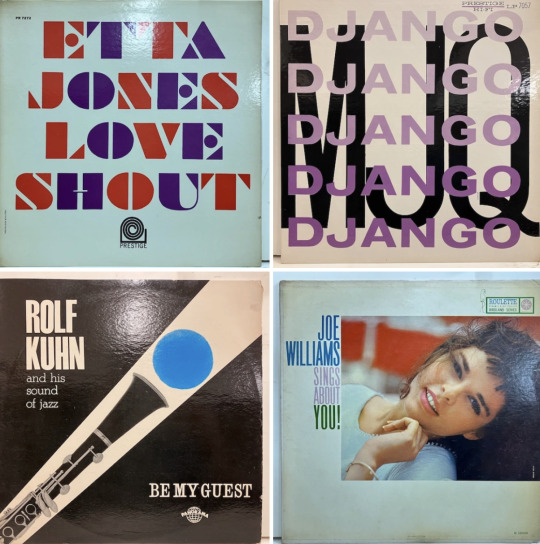
0 notes
Text
Wahl zum „Vogel des Jahres 2023“

(Foto: NABU/Mathias Schäf/Willi Rolfes/Markus König/Mirko Graul/stock.adobe.com/Benny Trapp/stock.adobe.com)
Fünf Kandidaten im Rennen um Vogel des Jahres-Titel
Stuttgart. (pm) Ab 02. September lassen der NABU und sein bayerischer Partner LBV (Landesbund für Vogelschutz) den Vogel des Jahres wieder öffentlich wählen. Jeder und jede kann unter www.vogeldesjahres.de mitbestimmen, wer Jahresvogel 2023 wird.
„Zuletzt haben bundesweit mehr als 143.000 Menschen bei der Wahl mitgemacht und mit dem Wiedehopf einen waschechten Baden-Württemberger zum Vogel des Jahres 2022 gekürt“, sagt der NABU-Vogelfachmann Stefan Bosch. „Es ist gut und wichtig, dass das Interesse an Naturschutz und der heimischen Vogelwelt so groß ist.“
Mehr als 300 Vogelarten leben in Deutschland. Die Vogelfachleute des NABU haben wieder fünf Arten ausgesucht, unter denen abgestimmt werden kann: Braunkehlchen, Feldsperling, Neuntöter, Teichhuhn und Trauerschnäpper.
„Sie alle stehen für Naturschutzthemen, die dringend mehr Aufmerksamkeit brauchen, und die sich auch in den Arbeitsschwerpunkten des NABU in Baden-Württemberg widerspiegeln“, erläutert der NABU-Fachbeauftragte für Vogelschutz.
„Die Klimakrise, das Insektensterben, die intensive Landwirtschaft und der Verlust von naturnahem Grün bedrohen die Bestände zahlreicher Vogelarten.“
Fünf Kandidaten – fünf Naturschutzthemen
Fröhlicher Luftakrobat. (Foto: Hartmut Mletzko)
Der Trauerschnäpper ist, anders als sein Name vermuten lässt, ein fröhlicher Luftakrobat. Er fängt sein Insekten-Futter im Flug. Doch Insekten gibt es immer weniger.
Außerdem hat er ein Zeitproblem: Weil der Frühling durch die Klimakrise immer früher beginnt, geht der Trauerschnäpper oft leer aus bei der Suche nach Bruthöhlen. Kehrt er aus seinem Winterquartier südlich der Sahara zurück, sind viele Baumhöhlen und Nistkästen schon besetzt.
Sein Slogan: „Schnappt zu für mehr Klimaschutz!“ In Baden-Württemberg gilt der Trauerschnäpper als stark gefährdet. Es gibt noch rund 2.000 bis 2.900 Brutpaare, schwerpunktmäßig an Rhein, Neckar, Donau und Bodensee.
Hat das Image eines Serienkillers. (Foto: NABU/CEWE/Karl-Heinz Epperlein)
Dem Neuntöter hat der Volksmund das Image eines Serienkillers verpasst. Das liegt am speziellen Umgang mit seiner Beute: Er spießt Käfer, Heuschrecken und Hummeln an Dornen und Stacheln von Sträuchern und Hecken auf, um sie später zu verzehren.
Trotz dieser klugen Vorratshaltung hat der Neuntöter immer weniger zu picken. Das liegt am immensen Einsatz von Pestiziden in der Landwirtschaft, einer der Hauptursachen für den Insektenschwund.
Sein Wahlslogan: „Schnabel auf für mehr Insekten!“ Trotz erheblicher Rückgänge an Bodensee und Donau kommt der Neuntöter noch landesweit vor, mit einem Bestand von 9.000 bis 12.000 Brutpaaren.
"Lasst es an Ufern wuchern! (Foto: NABU/Mathias Schäf)
Das Teichhuhn hält sich am liebsten im geschützten Uferdickicht stiller Gewässer auf. Solche grünen Ufer werden jedoch immer weniger. Schilf, Büsche und Bäume müssen oft zubetonierten oder kahlen Flächen weichen, Flüsse werden begradigt. Das Teichhuhn fordert darum: „Lasst es wuchern an Ufern!“ Noch brüten 1.500 bis 2.200 Teichhuhn-Paare im Südwesten.
Braunkehlchen mit Beute. (Foto: NABU/M. Schäf)
Das Braunkehlchen baut als Wiesenbrüter sein Nest am Boden. Damit hat es schlechte Karten, wenn in der intensiven Landwirtschaft Wiesen häufig gemäht werden und Ackerflächen selten brach liegen.
Ungemähte Blühstreifen könnten dem Braunkehlchen sehr helfen. Es tritt mit dem Slogan an: „Wiesen wieder wilder machen!“ Das Braunkehlchen ist in Baden-Württemberg mit wenigen 200 bis 320 Brutpaaren stark gefährdet und kommt nur noch punktuell vor. Das vom NABU betreute Schutzgebiet am Federsee beherbergt 100 Braunkehlchen-Reviere.
Lebt häufig in wilden Gärten. NABU/Kathy Büscher
Der Feldsperling war bei der vergangenen Wahl auf Platz vier gelandet und geht nun noch einmal ins Rennen. Er hat sich wie der Haussperling den Menschen angepasst und lebt häufig auch in unseren Siedlungen, in Gärten und Parks. Der Feldsperling braucht bunte Grünflächen mit alten Bäumen und entspannte Gärtnerinnen und Gärtner, die es ein bisschen wilder im Garten mögen. Darum fordert er: „Wilder Garten für mehr Arten!“ Im Land sind zwischen 65.000 und 90.000 Brutpaare zuhause.
Über die Wahl zum Vogel des Jahres:
Am 02. September öffnet der NABU das virtuelle Wahllokal unter www.vogeldesjahres.de. Bis zum Vormittag des 27. Oktobers ist jede und jeder eingeladen abzustimmen. Noch am selben Tag gibt der NABU den Sieger bekannt. Der „Vogel des Jahres“ wurde in Deutschland erstmals 1971 gekürt. Seit 2021 wird er durch eine öffentliche Wahl bestimmt.
Lesen Sie den ganzen Artikel
0 notes
Photo
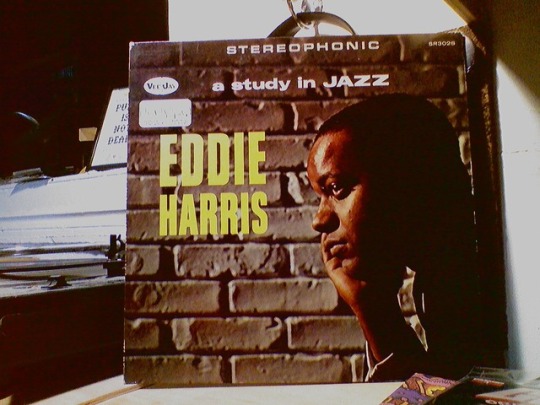
eddie harris “a study in jazz”
#eddie harris#willie pickens#melvin jackson#harold jones#joe diorio#richard evans#marshall thompson#roland faulkner
2 notes
·
View notes
Photo
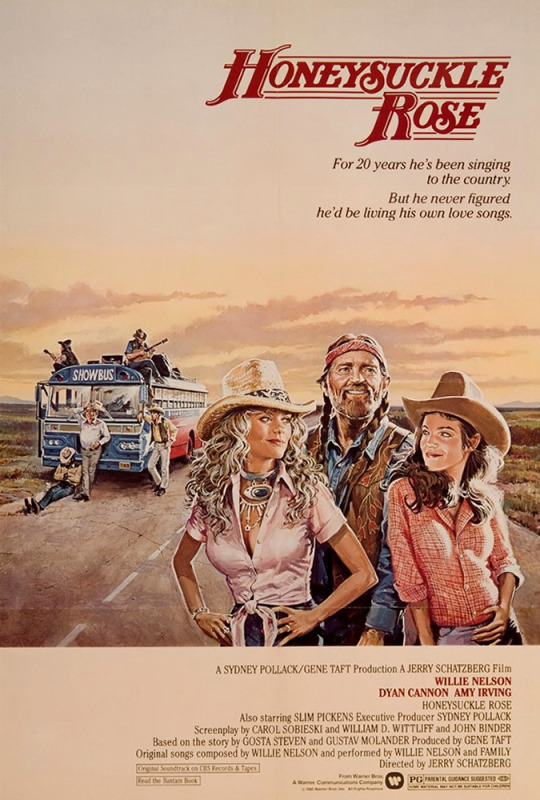
Honeysuckle Rose
14 notes
·
View notes
Photo

“Lt.(jg.) Harriet Ida Pickens and Ens. Frances Wills, first Negro Waves to be commissioned. They were members of the final graduating class at Naval Reserve Midshipmen's School (WR) Northampton, MA.," 12/21/1944
Series: General Photographic File of the Department of Navy, 1943 - 1958. Record Group 80: General Records of the Department of the Navy, 1804 - 1983.
#Harriet Ida Pickens#Frances Willis#Women Accepted for Volunteer Emergency (WAVES)#military history#women soldiers#WW II#world war ii#Northhampton#Massachusetts#Naval Reserve Midshipmen's School#black history#African American history#December 21#1944#1940s#1900s#archivesgov
116 notes
·
View notes
Video
youtube
Willie Pickens Trio - Dark Eyes
20 notes
·
View notes
Text
「どこに行っても自分より上手いプレーヤーはいる。だからまずは心を落ち着かせて自分のできることを続けなさい。自分のスタイルがあれば、競争はなくなる。だから、自分の好きなものを追求して自分のスタイルを確立するように努力を続けなさい。」
Willie Pickens
0 notes
Photo
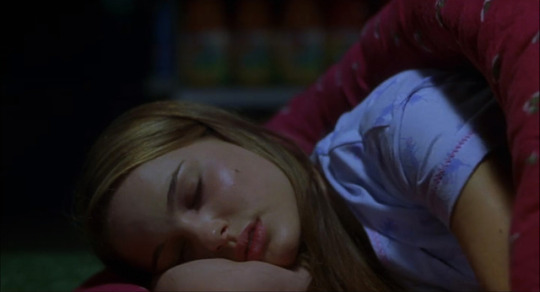

Where The Heart Is (2000)
#Matt Williams#Where The Heart Is#2000#2000s#y2k#Novalee Nation#Dylan Bruno#Willy Jack Pickens#dark comedy#drama#romance#films#movies#cinephile#cinematography#cinema#how i sleep at night#funny#millenium
1 note
·
View note
Text
The Tulsa Race Massacre – also known as the Black Wall Street Massacre and the Tulsa Race Riot – was one of the most horrendous incidents of racial violence in United States history. On May 31 – June 1, 1921, hundreds of people were injured and killed, and thirty-five blocks of the city were destroyed, along with over 1,200 homes.
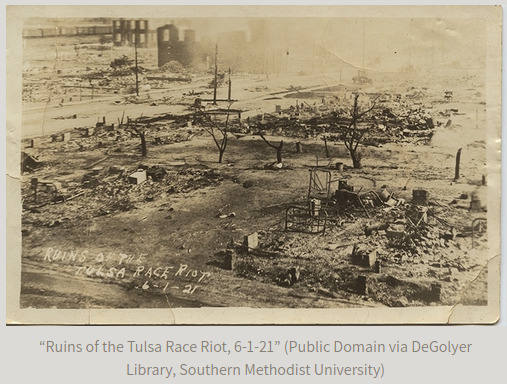
While relatively few whites exhibited empathy and compassion to the persecuted African American community of Tulsa – largely due to the influence of the Ku Klux Klan (KKK) and others – many Jewish families made efforts to help African American families by taking them into their homes or businesses, feeding and clothing them, as well as hiding them during and after the atrocity.
During the time of the Race Massacre, a number of the Jewish families went into North Tulsa to secure their black employees, friends, and their families, in order to protect them at least until Martial Law was over on June 3rd… some even longer.
Many of the Jews in the city were recent immigrants from Eastern Europe who remembered firsthand suffering through violent pogroms and anti-Semitic policies in the Russian Empire and elsewhere.
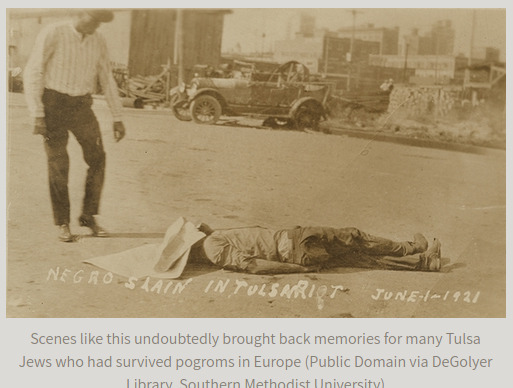
Here are a few family stories from that terrible time that have been passed down within the Oklahoma Jewish community.
Pickle vats and underskirts
Jewish Latvian immigrant Sam Zarrow (1894-1975) and his wife Rose (1893-1982) owned a grocery store and hid some black friends in their large pickle vats at the store, while Rose concealed some of the little kids under her skirt! In addition, they hid others in the basement of their home. Sam and Rose’s sons, Henry (1916-2014) and Jack Zarrow (1925-2012) became two of the most well-known and philanthropic men in Tulsa’s history, supporting a range of causes across the city.
Waiting with a shotgun
Tulsan Abraham (Abe) Solomon Viner (1885-1959) and his wife Anna (1887-1976) owned the Peoples Building and Loan Association. On the day of the Massacre, Abe went to all of the homes on his block, collected all of the maids from their quarters and assembled them in his living room. He then sat by the front door with a shotgun in case anyone broke into the house.
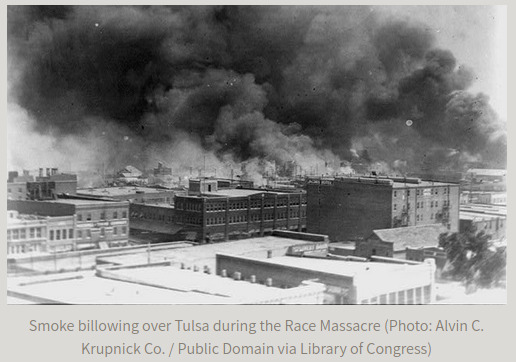
Threatening the Klan
The Race Massacre had a far-reaching effect even outside of Tulsa. At the time, Mike Froug (1889-1959), his wife Esther (1889-1967) and daughter Rosetta Froug Mulmed (1914-2003) were living in Ponca City, Oklahoma running a clothing store called the Pickens Department Store. Immediately after the Massacre, several Ku Klux Klan members came to his house at night and set a cross on fire on his front lawn.
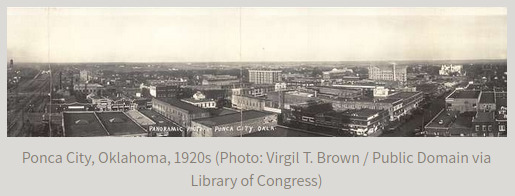
Knowing who the perpetrators were (frequent shoppers in his store), Froug went to the head of the Klan with his gun and told him that if they ever did that again, he would shoot them. This act had such a profound effect on Froug that when he and his cousin Ohren Smulian (1903-1984) opened the first Froug’s Department Store in Tulsa in 1929, they became the first store in the city after the Massacre to allow whites and blacks to not only shop together but to try on clothes at the same time. In fact, Frougs was also the first white-owned store in Tulsa to have black salespeople.
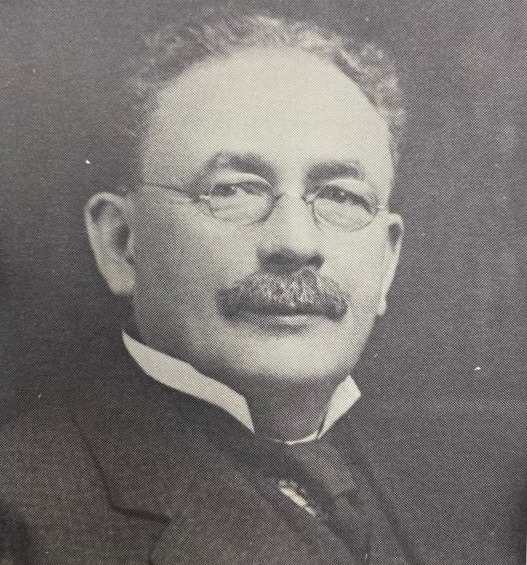

Jewish Lithuanian immigrant and oilman Nathan C. Livingston (1861-1944) and his wife Anna Livingston (1871-1934) had a newly married black couple named Gene and Willie Byrd working for them in 1921. Gene was the family driver while Willie was their housekeeper. During the Race Massacre, the couple and eight others of their family stayed in the Livingston’s basement and in their garage apartment for several days until they felt safe to go home. The following year, N.C. Livingston’s son Julius received a letter from the KKK telling him and his brothers Jay K. and Herman to “get your Jew crew out of Tulsa.”
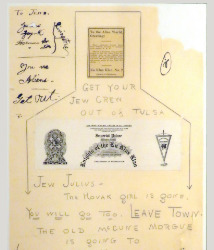
Staying home
During the Massacre, Jewish Lithuanian immigrant and oil producer Jacob Hyman Bloch (1888-1955) and his wife Esther Goodman Bloch (1895-1927) told their two young daughters, Jean and Sura, to stay away from the windows and no to go to school or outside to play, while hiding their housekeeper in their home.
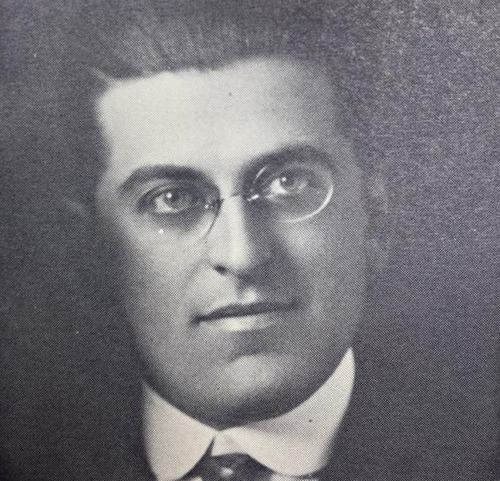

Driving to safety
Jewish Latvian immigrant Jacob Fell (1885-1959) and his wife Esther Fell (1886-1980) owned The Mis-Fit Clothing Store in Tulsa. During the race riots, Jacob gathered up several black friends, hid them in his large storage car trunk, and drove them to a safe area.
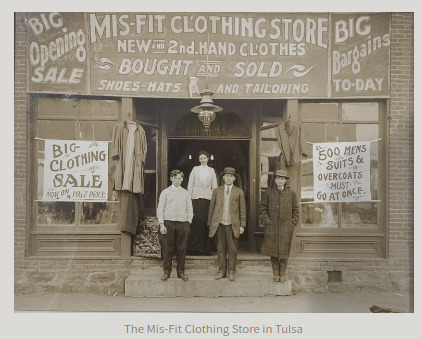
“But not you Mr. Katz”
In Stillwater, Oklahoma the Ku Klux Klan also had a robust chapter. German immigrant Jacob Katz (1873-1968) started his department store in Stillwater in 1894, becoming the first Jew in the town. Katz was a highly respected merchant and town promoter and was on the Stillwater Board of Commissioners. During the heyday of the KKK, right after the Tulsa Massacre, members marched through Stillwater with anti-Jewish signs (there were only 12 Jews in Stillwater at the time!), along with one that read at the end of the line: “But not you Mr. Katz.”
123 notes
·
View notes
Text
17 Curious Facts About The Cincinnati Bengals (And Their Forebears)
Welcome To Wilmington
Before every kick-off, Bengals fans are entertained with the dulcet strains of “Welcome To The Jungle” by Guns 'N' Roses. That tradition and the nickname for the Bengals’ home field dates to October 9, 1988 when three young men from Wilmington, Ohio – Dwayne DeWeese, Kyle Murphy, and Marty Marshall – unfurled a hand-painted sheet emblazoned with “Welcome To The Jungle” during a game in which the Bengals defeated the New York Jets 36 to 19. The iconic sheet has been lost, stolen from “The Jungle” during the next home game.
Dancing Allowed
That Bengals-Jets game on October 9, 1988 launched another unique Bengals tradition – the “Ickey Shuffle.” Elbert “Ickey” Woods played his entire, injury-shortened pro career with the Cincinnati Bengals where he was a record-setting fan favorite. Scoring twice against the Jets, Woods unveiled a celebratory dance that triggered an investigation by the League office. The powers-that-be deigned to allow Mr. Woods to shuffle his little heart out. He did, even shuffling away in a Geico insurance commercial.
Good Ol’ Whatsisname
Bengals wide receiver Chad Javon Johnson wandered through his career in a bit of an identity crisis. Wearing the number 85 on his jersey, Johnson announced during Hispanic Heritage Month in 2006 that he preferred to be called “Ocho Cinco,” meaning “Eight Five” in Spanish. (Eighty-five would be ochenta y cinco.) He legally changed his name to Chad Javon Ochocinco in 2008. In 2010, he declared that he would again change his name to “Hachi Go,” Japanese for “Eight Five.” (Eighty-five would be “hachijuu go.”) He did not go through with that plan and instead “reconnected to his former self” by legalizing a return to “Chad Johnson” in 2012.
Watch Your Mouth
Carl Pickens was drafted by the Bengals in 1992 and was named Offensive Rookie of the Year by the Associated Press after his first season. The Bengals must have agreed with that he was pretty offensive, because the back office created something now known as the “Carl Pickens Clause,” a sort of contractual loyalty oath that would forfeit all or some of his signing bonus if he ever insulted the Bengals in public.
A Hall-of-Famer, Twice
There aren’t too many folks who can claim membership in both the College Football Hall of Fame and in the Nashville Songwriters Hall of Fame. In fact there is probably only one: Mike Reid. A lot of rearview-mirror analysts wonder what the Bengals might have become had Reid not retired from football 1974 to focus on music, but he has done okay in his second career, penning hits for Ronnie Milsap, Willie Nelson and Wynona Judd, as well as a number-one country hit, “Walk On Faith,” he recorded himself.
A Home Team With No Home
The Cincinnati Celts were the first professional football team in the Queen City. Originally organized in 1910 as a semi-pro team for the unofficial “Ohio League” of the American Professional Football Association (renamed the National Football League after the team folded), the Celts were a “traveling team” playing all their games elsewhere. Among their few storied victories was a 9 to 6 win over Pine Village, Indiana (pop. 300) using a trick play. The Celts only played four league games in 1921, racking up a 1 and 3 record while being outscored 117 to 16.

Named In Momma’s Kitchen
The 1937 Cincinnati Bengals acquired their name from the stove in Josephine Pennington’s kitchen at 2233 Burnet Avenue in Mount Auburn. Josie’s son, Hal Pennington, had just founded a Cincinnati professional football team. He was also the head coach and general manager. The team did not have a name until one day, as he sat in his mother’s kitchen, he was struck by the forceful logo on her Floyd-Wells Co. “Bengal” range. Pennington’s team endured lackluster seasons until its merciful dissolution in 1940. Flash forward 27 years and Paul Brown decided to revive Pennington’s old name for his new team.
Bengals Football Was Good For Baseball, Too
The original 1937 Bengals were organized and coached by Hal Pennington, who arguably made his biggest mark later on in baseball. Pennington participated in all the sports offered at St. Xavier High School and Xavier University before trying to cobble together his pro football team. After the Bengals adventure, Pennington turned to baseball, coaching a number of Cincinnati-area teams and sending 11 of his players to the majors, including Ron Oester, Dave Parker and Buddy Bell.
Something Familiar About Those Models
Before Hal Pennington organized the league-level professional Bengals in 1937, he coached the semi-pro Cincinnati Model Shoes. The “Models” had a great year in 1936, but had to scramble to get opponents to show up. One day the coach for a team from Fort Wayne called to cancel because he didn’t have enough equipment for his players. Pennington told him not to worry, then drove over to Roger Bacon High School, where coach John “Socko” Wiethe let him raid the team locker. When Fort Wayne took the field a couple of priests from Roger Bacon commented on how familiar the Indiana uniforms were.
Socko Was Boffo
Among the few stars of the original Cincinnati Bengals was John “Socko” Wiethe. A standout at Xavier University, Socko joined the Bengals for their 1938 season, with home games played at XU’s stadium. Wiethe transferred to the Detroit Lions in 1939 and stuck around for four seasons in which he earned All-Pro honors while simultaneously playing professional basketball and basketball. He went on to coach UC Bearcat teams with great success, but lost out on a 1967 bid to own the new Cincinnati expansion team.
What’s In A Name?
“Socko” Wiethe wasn’t the only old Bengal to sport a playful moniker. The 1937 squad also boasted Alton “Blond Blizzard” Owen, Harry “The Horse” Mattos, Lee “Brute” Mulleneaux, Harrison “Tippy” Dye, Ben “Ducky” Ciccone and, of course, Harry “Mooney” Lightner. Mooney was the team’s kicker and was so proficient he gave exhibitions as the half-time show. He could accurately drop-kick from 35 yards out – and he always kicked barefoot.
Suspended In Arears
Often remembered as the worst team in NFL history, the Cincinnati Reds were an NFL team based in Cincinnati that struggled through a full (if lackluster) season in 1933. They played only eight losing games of an eleven-game season in 1934 before being suspended for not paying league dues. The team holds the record for the two lowest officially recognized season scoring totals in NFL history. In 1934, they scored only 10 points in the eight games they played before their suspension. After their suspension, the final three games of the 1934 season were picked up by the St. Louis Gunners.
He’d Rather Croon
A standout player on Cincinnati’s 1933 woebegone Cincinnati Reds football team was Jim Bausch, known as “Jarring Jim.” Bausch excelled in football and basketball at Wichita State University and the University of Kansas, then snagged a gold medal for the decathlon at the 1932 Los Angeles Olympics. He played pro football for the Chicago Cardinals before signing with Cincinnati. All along, Bausch insisted – to no one’s belief – that he really wanted to be a nightclub singer. After the disastrous 1933 season, Bausch ditched the team and launched his vocal career at Colonel Joe Anderson’s Club Mayfair in Covington. Bausch eventually settled on a career selling insurance.
They Grow Up So Fast
Benzoo, the Bengal tiger chosen in 1968 as the on-field mascot for the Bengals, so thoroughly enjoyed her Sunday outings to the stadium that she would pace impatiently in her cage at the Cincinnati Zoo as the hour for kickoff approached, and leap unprodded into the little cart for her weekly parade in front of 50,000 fans. Problem was, the 13-pound fur ball at the opening game was a 75-pound handful by season’s end and a 350-pound terror by next year. The Bengals went through seven Benzoos in their first 15 years.
Cincinnatus Never Got His Romans
Had the augurs read the birds differently (or the haruspices found a better liver), Cincinnati might be rooting on the Romans instead of the Bengals. As expansion fever enflamed the newly merged NFL and AFL in 1967, several investment groups lobbied to bring a team to Cincinnati. One syndicate, headed by former UC coach John “Socko” Wiethe, was so certain of victory that they incorporated and had their team name already picked out: the Cincinnati Romans, with a gladiator logo and helmets painted with laurel wreaths. The league went with Paul Brown’s Bengals instead.
Butts In The Seats
The Cincinnati Bengals played their first few seasons at UC’s Nippert Stadium while awaiting construction of Riverfront Stadium. They weren’t the only team waiting. To get the new stadium built, Cincinnati had to design a multi-use facility that would accommodate the Cincinnati Reds, too. Bengals coach Paul Brown, busy assembling a brand-new team from scratch, paid little attention to the details at the emerging Riverfront Stadium. When the city’s utility director, Wally Powers, called one day to ask Brown’s opinion on the red bleacher seats the Reds insisted on, Brown responded, “I don’t care what color they are. I want them filled with asses.”
Not Cold Enough For Guinness
Although Bengals fans of a certain age fondly recall the “Freezer Bowl” game on January 10, 1982 at Riverfront Stadium as the coldest afternoon of their lives, that AFC Championship match doesn’t show up in the record books. The actual coldest game in NFL history was played December 31, 1967 at Lambeau Field as the Green Bay Packers and the Dallas Cowboys battled for the NFL championship while temperatures hovered around -13 degrees. In comparison, Cincinnati’s “Freezer Bowl” was a relatively balmy -9 degrees.

#bengals#cincinnati bengals#cincinnati celts#reds football#cincinnati model shoes#floyd-wells#hal pennington#socko wiethe
13 notes
·
View notes
Text
Mickey Rooney’s Best Performance By Jessica Pickens

Mickey Rooney’s home studio wanted him to serve his country during World War II … but not in the way that you think. During World War II, Hollywood film studios helped express patriotic ideas through film. This could be through a film on soldiers experiencing military life, depicting Americana or Americans on the World War II homefront making sacrifices for those overseas.
As Metro-Goldwyn-Mayer’s top box-office draw, Rooney was cast in homespun comedies and musicals with wholesome values. Since 1937, Rooney starred in the Andy Hardy film series, where he played a teenager that figured out life, love and turned to his judge father for a “man-to-man talk” when he needed help. In total, there were 15 Andy Hardy films from 1937 to 1946 (and one later in 1958 with Andy Hardy as an adult) and they were hugely successful for the studio.
MGM felt that Rooney’s films, like Andy Hardy, personified American ideals and what servicemen and women were fighting for overseas. At least … that’s what MGM told the draft board.
With the war raging overseas, it was a real possibility that Rooney would be drafted, especially when other MGM contract players enlisted or were drafted. But studio heads wanted to keep Rooney out of the war and in front of film cameras, according to his biographers Richard A. Lertzman and William J. Birnes.

In 1942, Eddie Mannix, MGM executive and “fix it” man, sent formal documents to the local draft board to get Rooney an occupational deferment. Mannix cited the Andy Hardy films and their patriotism and that Rooney would soon begin production on another film important to the American homefront, THE HUMAN COMEDY (’43). Lertzman and Birnes noted that Mannix also stated the main reason MGM didn’t want Rooney in the military: the studio would lose millions.
The appeal was denied, but Rooney received an extension; allowing him to make THE HUMAN COMEDY. Based on a story by William Saroyan and directed by Clarence Brown, THE HUMAN COMEDY is a quiet story that follows an American family, the Macauley’s, during a year of adjustments in the small town of Ithaca. The film is narrated by Mr. Macauley, played by Ray Collins, who died two years prior. The eldest son Marcus (Van Johnson) is drafted. To help support the family, teenaged Homer (Rooney) gets an evening job in the local telegraph office. Homer’s family is rounded out by Ma (Fay Bainter), his sister Bess (Donna Reed) and his five-year-old brother Ulysses (Jackie “Butch” Jenkins).
As Homer gets more comfortable in his job, he matures and feels like everyone around him is changing — when it’s really just that he is growing up. As a telegraph delivery boy, he takes difficult messages to mothers who have lost their sons, and he has the responsibility of looking after alcoholic telegraph operator Willie Grogan, played by Frank Morgan. Everyone around Homer also changes and adapts. Bess and her friend Mary allow three soldiers on furlough to join them at the movies; knowing that soon they will see action on the battlefield. Homer’s boss Tom Spangler and socialite Diana Steed marry — bridging a social class gap and realizing that they are more similar than they think. Even Ulysses starts to learn more about life around him, like what it means to be afraid.

While the entire cast of notables play their roles superbly, Mickey Rooney is the standout performance in THE HUMAN COMEDY, and earned an Academy Award nomination for the role. In many of his other films, Rooney’s characters were variations of his Andy Hardy character. It didn’t matter if Rooney was portraying Huckleberry Finn or putting on a musical show with Judy Garland, shades of Hardy shine through.
But in THE HUMAN COMEDY, he plays the role in a restrained and mature manner. He’s emotional but doesn’t overact. It’s one of Rooney’s best performances. Perhaps because of a warning director Clarence Brown gave him: “The first time you shed an unnecessary tear or start any of the mugging you’re famous for, I’m going to halt everything, walk right out in the middle of the set, and give you a swift kick in the pants.”
Despite the early admonishing, Brown later said that Rooney was one of the greatest film talents and “could do no wrong in his book,” according to Brown’s biographer Gwenda Young. In one scene, Rooney had to emotionally read a telegram and react to the bad news. Brown was amazed that with each take, Rooney would “read it as though he’d seen it for the first time.” Brown and Rooney both later said that THE HUMAN COMEDY was one of the best films they made.

The film also features new talent such as Van Johnson, Donna Reed, Don DeFore, Barry Nelson and Robert Mitchum in his first film role.
Released in March 1943, the film garnered mixed reviews from critics, but ultimately was a success. Critics like Bosley Crowther of the New York Times said it was charming and had “moments of extraordinary beauty” but was also filled with “maudlin gobs of cinematic goo” when it came to some of the sermon-like dialogue. Critics overseas, who were closer to the battlefield, struggled with the message of “all men are angels,” according to Young.
As Rooney was filming THE HUMAN COMEDY, Mannix continued to submit appeals to the draft board from August 1942 to February 1943. Studio physician Dr. Edward Jones even stated that Rooney had a heart flutter, classifying him as 4F — unfit for duty, according to Lertzman and Birnes. Eventually, Rooney was able to serve his country more than in his film roles. Rooney was reclassified as 1A and he was enlisted in the Army in June 1944. Rooney later said he was proud of his service and continued to support veterans and attend World War II veteran ceremonies, including leading the Memorial Day Parade in Washington, D.C. in 2008.
#Mickey Rooney#Birthday#100th birthday#WWII#draft#Van Johnson#Donna Reed#Marsha Hunt#old hollywood#old movies#studio#MGM#TCM#Turner Classic Movies#Jessica Pickens
80 notes
·
View notes
Text
Attractions Galore During Summer Vacation Trips to Happening Places in Tampa, Florida
If you're looking for a fun and exciting place to go to with your family and love ones this summer, Tampa Bay is the place for you. Situated in the middle of the country is Tampa Bay, a wonderful bay surrounded by pine trees and bays. If you are planning to visit Tampa click here, chances are you might be also considering the prospect of taking part in water sports there. There are many places where you can indulge in the water sports but these places are not limited to the beach or into the deep waters. You can enjoy a wide range of water sports at Tampa Bay like scuba diving, snorkeling, kayaking, fishing, parasailing, wind surfing, jet skiing and a lot more.

If you happen to find yourself craving for something sweet, then you may want to try out the ice cream shops of Tampa Bay. Not only that ice cream is a favorite ice cream of young and old alike but it is also a great way to cool down during the hot summers of summer. The best place to find ice cream in Tampa Bay would be at places that have waterfront restaurants so you can enjoy the waterfront view while you get a cool treat.
If you love shopping, Tampa Bay offers some of the best shopping districts in America. The Hillsborough Street area has boutiques that sell everything you can think of from books to clothes to electronics to antiques. There are also places in downtown that offer specialty foods and fresh seafood. One popular place is the Mango Tree, which sells mangoes and other tropical fruits from various regions around the world. You can also check out the retro clothing boutique called the Willy Wonka for great vintage finds. In terms of arts and culture, the Tampa Bay area offers museums that include the Museum of Art and the Chrysler Museum of Art.
If you love the nightlife in Tampa, then you should head to its night clubs and bars. Some of the hottest places to visit are The Rumsey Pickens Bar and Grille and The Roxy. They offer great food and a great time for music and dancing. You can also visit the Tampa Night Market to browse through hundreds of stalls filled with local crafts and merchandise.
The beaches near Tampa Bay are also a top attraction during summer vacation trips. The beaches near Tampa Bay are lined with beautiful accommodations for summer vacations. Hotels in the area cater to both luxury tourists and families and singles who enjoy beach houses in the sun. These hotels offer amenities such as indoor pools, fitness centers, meeting spaces, and spas. If you want to shop, then you can go to the Shoppers Paradise in Westshore.
If you want to experience a different kind of summer vacation, then consider staying at one of the Tampa Bay area motels. These types of hotels offer top-notch hospitality and comfortable rooms. They also offer beach access so you can swim and snorkel along the coast. Most of these hotels have packages that include meals, champagne, and taxes at an inexpensive price. In addition to beach access, they also offer golf and tennis courts and many have onsite parking.
1 note
·
View note